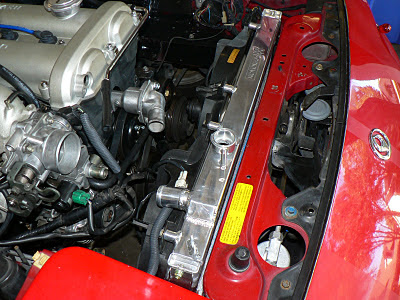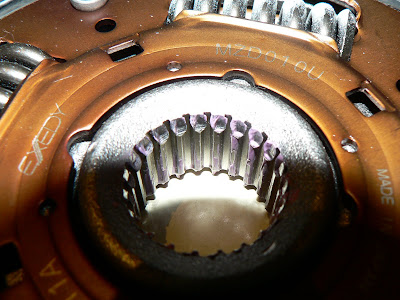With the help of a couple friends, I figured out why my new '99 head was making such a racket. It's got the wrong exhaust cam in it. I got the '99 head from a friend of mine. It's been in storage for over 10 years and its exact history is a little fuzzy. It came completely assembled but the cams were just loosely held in the journals with the bearing cap bolts finger tight. As seen much earlier in this blog, I took it apart and lapped the valves, checked the bottom surface for straightness, and put it back together.
What I've been hearing since I first started it up was what sounded like excessive valve lash. It was quite loud so I knew something wasn't right. I had checked all the clearances when I installed the head and they were pretty good. If anything a couple of them were on the tight side, not loose. Nevertheless, I figured I had screwed something up so this morning I popped the valve cover off and measured the clearances. None were above the maximum spec, but a couple were below the minimum, so I fired up my spreadsheet and plugged in all the numbers and identified 4 shims I could swap with each other that would bring everything within the factory specs. I was able to get the shims out without completely taking out the cams or having to re-do the timing. If you loosen the bearing caps and rotate the engine you can sneak the shims out from under the cam without removing the timing belt.
I was very glad to get the clearances better adjusted. Most of the valves are in the bottom half of the range. Alas, the noise was unchanged, so I put out a mayday to some gearhead buddies. One of them asked if I was sure I was using the right cams because the cams for NA and NBs have a different profile due to (or at least coincident with) the change to solid lifters in '99. I just used the cams that came with the head, but I realized that I took it on faith that they were the right cams.
From Solomiata.com:
 Note the NB cam on the left has a more rounded profile, while the cam on the right from an NA is more pointy.
Note the NB cam on the left has a more rounded profile, while the cam on the right from an NA is more pointy.To seal the deal, I spotted the marking on the intake cam, BP4W, which is indeed the correct intake cam for the head. On the exhaust cam is BP06, which is an NA cam. Bzzt. Wrong cam. So I'll be ordering up an NB exhaust cam and I'm debating whether to also order the BP5A (aka Mazdaspeed cam) for the intake side. Would be easy to swap it out as long as I'm in there swappin'. Hope this helps save someone some trouble sometime. Never assume!



















































